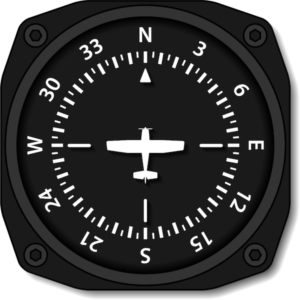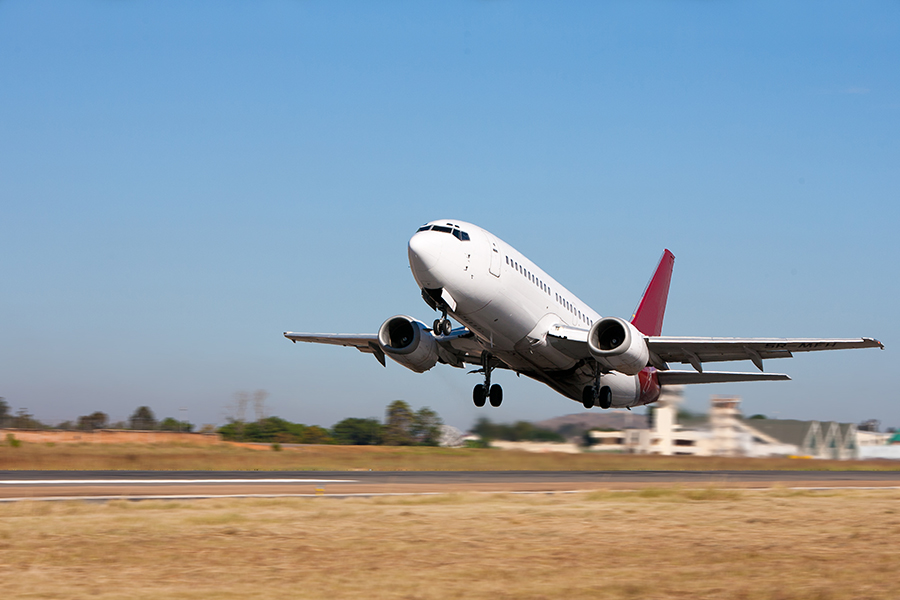The magnetic compass has long been a staple of aviation navigation, and the basic liquid compass, essentially unchanged for decades, is still used today as a backup instrument. 14 CFR § 91.205 requires that all aircraft have magnetic compasses, and for a good reason – The magnetic compass is an entirely self-contained system, requiring no external input to function during flight.
However, to use it properly, you need to know the science behind the instrument and compensate for its limitations.
This article will look at the magnetic compass in detail and shed some light on an often overlooked but vital part of the flight deck.

What is Magnetism?
To understand how a magnetic compass works, you need to understand the basics of magnetism.
The Earth
The Earth is itself a giant magnet, and its magnetic field comprises of magnetic lines of flux. A flux line is a magnetic line of force that begins at the magnet’s north pole and ends at the magnet’s south pole. These invisible lines of force create the Earth’s magnetosphere (the area affected by the Earth’s magnetic field).
Counterintuitively, the Earth’s magnetic north pole is located close to the geographic South Pole. The Earth’s flux lines emanate from an area close to the geographic South Pole and end at a location close to the geographic North Pole.
Magnets
As a pilot, understanding a magnet’s behavior is essential to understanding the magnetic compass and how magnetism influences the aircraft in general. The composition of a magnet and its formation, although interesting, is beyond the scope of this article.
A magnet comprises of materials such as iron, steel, or cobalt and attracts or repels other magnets. A magnet has a North and a South pole – the opposite poles will attract, whereas the similar poles will repel. Any magnet that can freely rotate will align itself with the Earth’s magnetic poles. The relationship between magnets and their poles forms the base of how the magnetic compass functions.
Magnetic Compass Construction
A magnetic compass is a self-contained system that does not require electricity and is often used as an emergency or standby instrument. The magnetic compass involves two simple magnetic bars suspended in liquid (usually a liquid similar to kerosene). The liquid assists in keeping the magnets stable while allowing them to rotate freely. Attached to the magnets is afloat, which looks similar to a frisbee. The float allows the compass fluid to dampen out any unwanted movement of the magnets. Attached to the float is a compass card with marked directions, usually with the zeros removed (e.g., 33 instead of 330).

On the front of the compass is a lubber line, a vertical line in the center of the compass, allowing the pilot to read the compass’s direction accurately.
One of the primary distinctions between a heading indicator and a magnetic compass is that the compass appears to move in the opposite direction of the turn. For example, when flying due north, west is indicated right of the lubber line. This apparent backward motion is due to the compass housing remaining stationary while the aircraft effectively moves around it.
A compensator assembly is mounted on the top or bottom of the compass, creating a magnetic field that reduces the influence of external magnetic fields. This assembly consists of two magnets fixed onto two shafts. A screwdriver is used to move these shafts into a specific position.
History of Magnetic Compasses in Aviation
As is the case for many great inventions that made their way into aviation, the liquid compass was first used onboard ships.

The first liquid compasses specifically made for aircraft were introduced in 1909 but, although practical, were very rudimentary. It was only until the 1930s when liquid compasses made for aircraft became practical, with the compass only requiring four seconds to settle compared to over 30 seconds of previous models.
The magnetic compasses designed in the 1930s led to the modern liquid compasses of today, a design that has remained essentially unchanged for decades.
Magnetic Compass Errors
The magnetic compass, unfortunately, suffers from many errors. These errors can be compensated for to ensure the compass indicates as accurately as possible.
The magnetic compass suffers from the following errors:
Variation
Coordinates are referenced to “true” north and south, meaning the geographic North and South Pole. The magnetic poles are not located in the same place as the geographic poles (the magnetic North Pole is located in Canada, and the magnetic South Pole is located south of Australia). The magnetic compass will therefore not indicate true north and south but rather magnetic north and south.
The difference in direction between magnetic and true direction is called variation. To compensate for variation, you will use the isogonic lines on an aeronautical chart. These isogonic lines join places of equal variation and will provide you with the magnetic variation of a particular area. Using these lines, you will either add westerly variation or subtract easterly variation to a true direction to obtain the magnetic direction.
Deviation
The deviation is the effect of the aircraft’s magnetic field on the magnetic compass. The airplane experiences its own magnetic field due to materials in the aircraft that have been magnetized and electricity in the vicinity of the compass. The deviation is independent of location and is affected by heading and changes in the aircraft, such as the activation of electrical components.
The deviation is compensated for by measuring the difference between the compass’s indicated magnetic heading and the actual magnetic heading measured by a different, calibrated compass. This procedure is called a “compass swing.” Using the compass swing procedure, the compass is adjusted using the compensator assembly. Any deviation that cannot be corrected is indicated by a “compass card” located in the cockpit, usually on the compass itself. This card indicates what the actual magnetic heading is versus the magnetic heading indicated by the compass for a given direction.
A compass swing must be performed when:
- The accuracy of the compass is in question.
- Following a flight through a severe electrical storm.
- After a lightning strike.
- After modification of the cockpit or significant replacement involving ferrous metal.
- Whenever a change is made to the aircraft’s electrical system.
- When a change in cargo has the potential to affect the compass.
- Every time a compass has been subjected to impact, such as after a hard landing or turbulence.
- When the aircraft is relocated to a different location with a significant change in magnetic deviation.
- If the aircraft has been parked on one heading for over a year.
Magnetic Dip
The compass will tend to dip toward the closest magnetic pole due to the inclination of the flux lines. This error is most pronounced close to the poles because the flux lines become more “vertical” (in relation to the Earth’s surface) closer to the poles. At the equator, the flux lines are parallel with the surface of the Earth, minimizing these errors.
To mitigate this error, the compass magnet is weighted at either the southern end (in the Northern Hemisphere) or the northern end (in the Southern Hemisphere).
Turning Error
Due to magnetic dip, the magnetic compass experiences another error when the aircraft is banked: turning error.
When the aircraft is banked during northerly and southerly headings, the magnet will dip, causing the compass card to rotate. This error is negligible at the equator, where the Earth’s flux lines are parallel to the surface.
To compensate for this error, pilots must purposefully overshoot or undershoot turns onto northerly or southerly headings when using the magnetic compass. A rule of thumb for the Northern Hemisphere (opposite in the Southern Hemisphere) is Undershoot North, Overshoot South (UNOS).
Acceleration and Deceleration Error
Due to the weight used to correct the magnetic dip, the compass experiences an acceleration and deceleration error.
When the aircraft accelerates, the weight lags behind (in the Northern Hemisphere) or moves ahead (in the Southern Hemisphere) of the card, causing the card to move. When the aircraft’s speed stabilizes, the indication returns to normal.
Unfortunately, there is no real way to compensate for this error, and pilots must be aware of it to ensure that they do not rely on faulty compass indications. The rule of thumb for this error in the Northern Hemisphere (opposite in the Southern Hemisphere) is Accelerate North, Decelerate South (ANDS). This means that, in the Northern Hemisphere, the compass will indicate towards the north when accelerating and towards the south when decelerating.
Oscillation Error
The oscillation error is caused by the movement of the compass card inside the compass fluid. This movement may be due to maneuvers of the aircraft or turbulence. The compass fluid provides damping but cannot prevent all unwanted movement of the compass card. Compass oscillations are generally observed as a swinging back and forth of the compass.
Conclusion
The magnetic compass is a brilliant instrument that works with the Earth to provide us with direction indications. To use it properly, however, you do need to respect its limitations. Next time you go flying, try using the compass – It will add another layer of proficiency to your belt.




